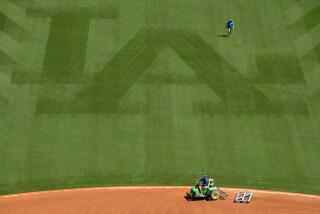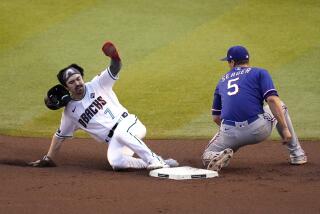Defense Provides Baseball Magic
Defense is baseball’s highlight reel, its great and most reliable source of surprise, spontaneous creativity and pure athletic beauty. In a sport that is defined by the confrontation between pitcher and hitter, it is the taut array of fielders who surround that central battle that provide an infinitely varied kaleidoscope of fresh possibility.
Hitters and pitchers have their quirks, their individual stances and windups, which often mirror their personalities. Yet there’s a sameness to them all. Every baseball, thrown or batted, has a familiar arc. Sometimes a ball goes 100 mph or flies 500 feet, but that’s just a few breathtaking percent beyond the game’s norm.
For surprise, defense always offers the game’s best chance to amaze us, send us home muttering, as we claim we do after any game, “Well, I never saw that before in my whole life.”
Ken Griffey Jr. never climbs the center field wall exactly the same way twice. Why? Because no two long blasts ever fly exactly the same way, on the same trajectory, through the same breeze, with the sun in your eyes exactly the same way or with a teammate on a collision course for you at exactly the same speed. Willie Mays once noticed that his right fielder was standing, back to the plate, watching a ball fly over the wall. Mays climbed his back and got it.
Do you fly, eyes fixed on the ball, no matter where it takes you--like Pete Reiser or the young Bobby Valentine--even if it takes your career into oblivion? Or do you make judgments of relative value, unrelated to the game, as you run full speed, hear the crowd, imagine your teammates and what they’ll think of you?
During fielding practice before every game, players work on fundamentals, trying to utterly erase misfortune from basic plays.
“Make the routine plays and the great plays will take care of themselves,” the old-timers say. Though Brooks Robinson bare-handing a bunt proved you could meld “great” with “routine.”
Yet once the game starts, you realize those pregame drills are only half the truth. Defense is one part mastering the mundane and one part perpetual amazement at what the game can throw at you that is slightly, or diabolically, different.
Once Ozzie Smith dived behind second base just as the ball hit a rock and bounced crazily behind him. The Wizard reached backward in flight, barehanded the ball in midair, hopped to his feet and threw his man out. You’re forgiven for the bad hops. Yet every bounce is unique as backspin switches to topspin. If the moment’s right and the ball takes a flat skip just as you sneak a peek at the base runner, you can be Bill Buckner. Forever.
Defense is our infinite spontaneous variation on familiar patterns, a fresh twist or even a full Ozzie flip. A box-seat railing or a charging 200-pound runner make a dozen plays per game into something just a little bit unique, and occasionally, ominously dangerous. Your toes might end up pointing at the moon.
That pop fly, like a million before it, triangulates with perfect diabolical intent among three sprinting defenders. You can practice it all your life. You can scream, “I got it” into a wall of 40,000 voices. But it’s not like any other “flare.” This could be the best play you ever made. Or the one you wish you’d never tried.
Sometimes, defense can even be a moment of strategic discovery. If you’re Derek Jeter in last year’s American League Championship Series, you may decide to invent a new shovel-pass cut-off play--something no one had thought of in 133 previous major league years--and pull it off on the spot to save a game and a Yankees pennant.
Once, in Cuba, a quadruple play decided the island championship. Bases loaded, bottom of the ninth, home team one run behind. Liner to right in the gap. On instinct, the runners go. Diving catch. Throws back to second, then first for a triple play. But the runner on third has tagged in the meantime to score and tie the game. Defensive team appeals that the runner at third left too soon. Appeal upheld. “Fourth” out. Run denied. Game over.
That’s the gasp of the unexpected-like three runners (usually Cubs) standing on the same base-which energizes defense. In the ’80 World Series, a foul pop jumped out of catcher Bob Boone’s mitt. But Pete Rose anticipated the mistake and caught it. Second baseman Billy Martin once saved the last game of a Series by realizing nobody had called for a popup near the mound. He made a diving catch.
Baseball is the only major sport in which athletic ability is routinely subordinated to form. Strength, quickness and technique are compacted into one gesture--the pitch or the swing--that is repeated endlessly.
Defense is where baseball lets the genie of athletic genius and the flair for inspiration have an equal place beside the game’s vast respect for the studious perfection of quotidian routine. Baseball celebrates dogged dailiness, craftsmanship and a million mind games full of strategy and situational memory.
More to Read
Go beyond the scoreboard
Get the latest on L.A.'s teams in the daily Sports Report newsletter.
You may occasionally receive promotional content from the Los Angeles Times.










